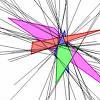I've been a user of the PB 420E auto for 3 years, and had been doing some reading about it. I'm not a sleep professional in any way. My recent reading has convinced me the PB algorithm was planned for a special kind of setup.
When setting up the PB 420E (Puritan Bennett with the Evolution Algorithm) there are 4 different pressures you should look at:
Initial - where the machine goes when you turn it on and when the ramp is finished
Ramp - can start as low as you want, and you can make it lower than the minimum
Minimum - the lowest pressure the machine will go down to when in therapy mode
Maximum - the highest pressure the machine will go up to when in therapy mode
4 different pressures to set.
When PB submitted the machine to the FDA, the automatic mode's function was described as follows:
(my emphasis added:)
http://www.fda.gov/cdrh/pdf3/k031470.pdf
The following sentence, in a paper on cardiogenic oscillations by D.M. Rapoport, ( http://www.chestjournal.org/cgi/content/full/116/3/660 ) sent me on a patent search.The GoodKnight 420 Evolution can operate in either Constant or Automatic mode. In Constant mode, the device delivers a constant positive airway pressure to the patient at a fixed level prescribed by the practitioner between 4 and 20 cmHrO. In Automatic mode (APAP mode), the practitioner sets a maximum and minimum pressure range above and below the prescribed reference pressure and between 4 and 20 cmHz0. The pressure is adjusted within this range according to the patient’s respiratory pattern and the type of respiratory events detected. Data concerning the type of events detected, their frequency and duration, etc. is stored in the device data memory and can be accessed by the practitioner through the use of the optional Silverlining'" software. Pressure delivery for
the GoodKnight 420 Evolution is regulated by a pressure sensor which monitors both ambient and output pressure and provides feedback to the control system.
"Dr. Rapoport and Mr. Norman have a financial interest in the development of automatic CPAP in the form of patent rights (assigned to New York University and licensed to Mallinckrodt Nellcor Puritan Bennett)"
If you read US Patent no. 5803066, (also no. 5,546,933) given to Rapoport et. al. and licensed to PB, you will see that the licensed auto algorithm assumes the existence of a prescribed pressure, a "preferred" pressure which is neither the min. nor the max. of the range. I'm adding emphasis to the quote, from pat. 5803066:
This is from patent no.
The above mentioned preselected prescribed pressure is the 420E's initial pressure.38. A breathing device for optimizing the positive airway pressure to a patient, comprising:
a source of breathing gas at controlled positive pressure to the airway of a patient;
a flow sensor configured to generate first data values representative of an inspiratory flow of breathing gas to the patient;
computer memory configured to store the first data values generated by said flow sensor;
a microprocessor including means for calculating the area of the inspiratory waveform from said first data values and calculating the area of a pure sine wave to generate a ratio of said areas and configured to generate a first signal when said ratio indicates a flow limitation in the patient; and
a pressure controller responsive to the first signal from said microprocessor and coupled to said source of breathing gas for increasing the positive pressure to the airway of the patient.
39. The breathing device of claim 38 wherein said micropressor is further configured to cause said pressure controller to increase the positive airway pressure to the patient at a greater rate when said positive airway pressure is less than a preselected prescribed pressure that (sic) when said positive airway pressure is greater than said preselected pressure.
40. The breathing device of claim 38, wherein said microprocessor is further configured to cause said pressure controller to decrease the positive pressure to the airway of the patient when said ratio does not indicate a flow limitation in the patient.
41. The breathing device of claim 40, wherein said microprocessor is further configured to cause said pressure controller to decrease positive airway pressure to the patient at a greater rate when said positive airway pressure is greater than a preselected prescribed pressure than when said positive airway pressure is less than said preselected pressure.
When you don't set an initial pressure, initial and min. default to same. Meaning that you are set up for a slow rise (inhibiting the machine's preemptive capabilities) and speedy decrease back to your minimum - with not much chance of stabilizing around a preferred pressure, since the machine assumes preferred=min.
If you do set up an initial pressure, and make sure it is higher than the minimum, an closer to your preferred or prescribed pressure therapy will start at that pressure, and the pressure will drop if there are indications of airway stability. Once below the initial pressure, the machine will be more responsive to flow limitations, snores etc. On reaching the initial pressure, the rate of change upwards will slow down, and further pressure will be added more carefully, Once higher than your preferred pressure, it will drop back to that quickly and then drop further more carefully.
The bottom line is that you have more chances of staying at or below an optimal pressure if you tell the machine what that optimal pressure is - and you do that by setting it as the initial pressure.
The difference in rate of change is true for all breathing events. Not setting up the initial pressure therefore hobbles the PB's ability to respond quickly to apnea precursors. And also hobbles its ability to respond differently when below the optimum and when above it
Now, the machine does start therapy mode out at initial pressure. Which is why ramp is crucial (not optional) in this automatic machine. If your initial pressure is too high for comfort, you use the ramp to fall asleep. The machine checks your breathing at optimal pressure, and will gladly drop you down if everything is OK.
In summary:
Initial - where the machine goes when you turn it on and when the ramp is finished - (I now set it up with the pressure recommended in my PSG)
Ramp - can be handled like any ramp - based on comfort.
Minimum - the lowest pressure the machine will go down to when in therapy mode - you may want this for many comfort reasons.
Maximum - the highest pressure the machine will go up to when in therapy mode - you may want this for those times your initial is not enough.
Edit: added "for three years" to "user" and "recent" to "my reading"
O.
_________________
CPAPopedia Keywords Contained In This Post (Click For Definition): 420E, respironics, Puritan Bennett, CPAP, Ramp, auto











